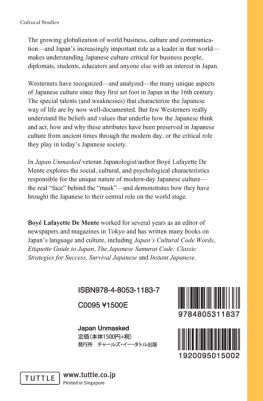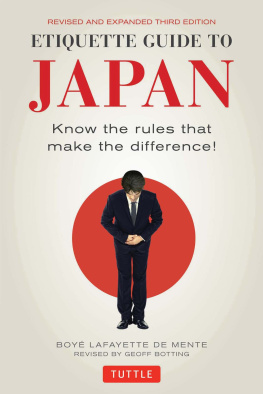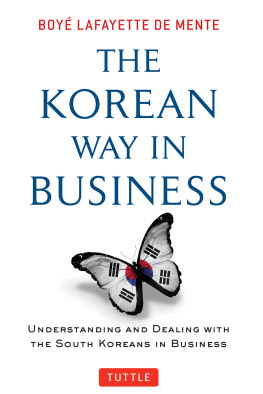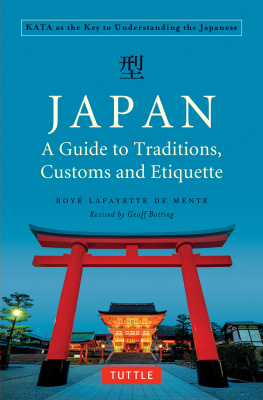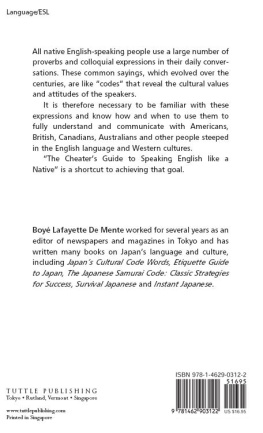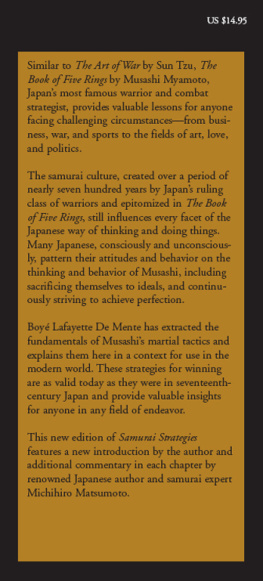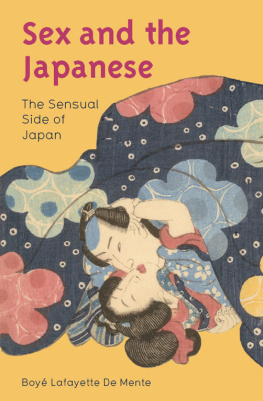Boye Lafayette De Mente - Japan Unmasked: The Character and Culture of the Japanese
Here you can read online Boye Lafayette De Mente - Japan Unmasked: The Character and Culture of the Japanese full text of the book (entire story) in english for free. Download pdf and epub, get meaning, cover and reviews about this ebook. year: 2006, publisher: Tuttle Publishing, genre: Politics. Description of the work, (preface) as well as reviews are available. Best literature library LitArk.com created for fans of good reading and offers a wide selection of genres:
Romance novel
Science fiction
Adventure
Detective
Science
History
Home and family
Prose
Art
Politics
Computer
Non-fiction
Religion
Business
Children
Humor
Choose a favorite category and find really read worthwhile books. Enjoy immersion in the world of imagination, feel the emotions of the characters or learn something new for yourself, make an fascinating discovery.
- Book:Japan Unmasked: The Character and Culture of the Japanese
- Author:
- Publisher:Tuttle Publishing
- Genre:
- Year:2006
- Rating:4 / 5
- Favourites:Add to favourites
- Your mark:
- 80
- 1
- 2
- 3
- 4
- 5
Japan Unmasked: The Character and Culture of the Japanese: summary, description and annotation
We offer to read an annotation, description, summary or preface (depends on what the author of the book "Japan Unmasked: The Character and Culture of the Japanese" wrote himself). If you haven't found the necessary information about the book — write in the comments, we will try to find it.
Boye Lafayette De Mente: author's other books
Who wrote Japan Unmasked: The Character and Culture of the Japanese? Find out the surname, the name of the author of the book and a list of all author's works by series.
Japan Unmasked: The Character and Culture of the Japanese — read online for free the complete book (whole text) full work
Below is the text of the book, divided by pages. System saving the place of the last page read, allows you to conveniently read the book "Japan Unmasked: The Character and Culture of the Japanese" online for free, without having to search again every time where you left off. Put a bookmark, and you can go to the page where you finished reading at any time.
Font size:
Interval:
Bookmark:


CHAPTER
Dispelling the Enigma
Myth of Japan
The Japanese are probably the most knowable and predictable people on Earth! George H. Lambert, Japanologist
Differences in the attitudes and behavior of Westerners and Japanese are frequently so great and conspicuous that ordinary explanations of cultural variations do not suffice. Foreigners have long presumed that there was something mysterious in the makeup of the Japanese character that accounted for these extraordinary differences. This presumption long ago led to the creation of a Mystery of the Orient myth that has been a primary theme in most of the Western writings on Japan, and has profoundly influenced virtually all of our relations with the Japanese.
To complicate matters further, the Japanese themselves have historically suffered from a similar malady that might be called the Mystery of the West. Noting this phenomenon, Japanologist George H. Lambert said: They [the Japanese] often react to us according to old and well-preserved stereotypes with behavior patterns that are incompatible with their normal conduct. Thus it happens that we are often reacting to abnormal Japanese behavior that is in itself a reaction to us.
What is it, then, that accounts for the extraordinary differences between the Japanese and Westerners? Why can two people who obviously have a great deal in common still have so many major differences in the way they think and behave? Is Japan really a black hole from which the light of understanding cannot escape? Is there anything at all enigmatic about the Japanese way of doing things?
Actually, as George Lambert commented years ago, there is probably no people on the face of the earth as explainable as the Japanese, due to their formalized culture and systemized role playing, which influences the deepest and most personal levels of their attitudes and behavior. The barrier that blocks Westerners view and understanding of the Japanese is Westerners own veil of cultural myopia, their own ignorance of the essence of Japanese culture.
Western experts have been dissecting and analyzing the anatomy of Japanese culture since they first set foot in Japan in the sixteenth century. They have also spent a lot of time and energy delving into the origin and nature of the famous Japanese spirit. But no one to my knowledge has ever identified the Rosetta stone of Japans distinctive culturethe keys that unlock both the mystery and mystique associated with how the Japanese do business and conduct all of their personal and professional affairs.
While most of the special traits and talents that brought the Japanese to the center of the world stagealong with their weaknesses and failingshave been accurately described by foreign businessmen, writers, and scholars, no one has yet explained where these special traits and talents came from, how they became an integral part of Japanese culture, and how they actually work.
I believe that all of the primary attributes for which the Japanese are knowntheir strengths as well as their weaknesses have their genesis in the cultural molds referred to as kata (kahtah), form/way, or shikata (she-kah-tah), way of doing things. I believe that the shikata provide the ultimate answer for what makes the Japanese Japanese the good as well as the bad. A full understanding of the nature and role of the hundreds of shikata that make up the Japanese Way is absolutely essential before anyone can understand the Japanesein fact, before the Japanese can understand themselves.
Form as Reality
When used in the Japanese context, the shikata concept includes more than just the mechanical process of doing something. It also incorporates the physical and spiritual laws of the cosmos. It refers to the way things are supposed to be done, both the form and the order, as a means of expressing and maintaining wa (wah), harmony, in society and the universe. The absence of shikata is virtually unthinkable to the Japanese, for that refers to an unreal world, without order or form.
Early in their history the Japanese developed the belief that form had a reality of its own and that it often took precedence over substance. They also believed that anything could be accom plished if the right kata was mentally and physically practiced long enough.
Japan has no genuine philosophy as such, only form, says Kazuo Matsumura, assistant professor of Japanese mythology at the Oyasato Institute at Tenri University in Nara. He adds, however, that most Japanese today are ignorant of the roots of much of their kata -ized behavior.
Most of Japans numerous kata have been well established for centuries. Over the generations the kata not only became institutionalized they also became ritualized and sanctified. Doing things the right way was often more important than doing the right things.
Eventually, the proper observance of kata was equated with morality. One was either in katakata ni hamaru (kah-tah nee hah-mah-rue)or out of katakata ni hamaranai (kah-tah nee hah-mah-ray-nigh). Being out of kata was a sin against society, and in form-conscious Japan this could be fatal. Ethics gave way to styles; principles gave way to policies.
Just as there was only one acceptable way to perform all the various actions of life in preindustrial Japan, from using chop-sticks to wrapping a package, there was naturally only one right way of thinkingthe Japanese way. Cultural conditioning based on the kata system made the Japanese extremely sensitive to any thought, manner, or action that did not conform perfectly to the appropriate kata . In formal as well as most daily situations every action was either right or wrong, natural or unnatural. There were no shades of gray that accommodated individualistic thought, preferences, or idiosyncrasies.
To the Japanese there was an inner order (the individual heart) and a natural order (the cosmos), and these two were linked together by formby kata . It was kata that linked the individual and society. If you did not follow the correct form, you were out of harmony with both your fellow man and nature. The challenge facing man was to know his own honshin (hone-sheen), true, or right heart, then learn and follow the kata that would keep one in harmony with society and the cosmos.
Origins of the Kata Culture
The shikata that make up the Japanese Way began as mechanical processes designed to perform specific actions and create specific products. Among the earliest and most pervasive of the shikata were the way of wet-rice farming, the way of court etiquette, the way of writing Kanji , the tea ceremony, the making of arts and crafts, the way of the samurai, the use of the Japanese language, and a strict daily etiquette based on a hierarchical system of seniority and sex.
Wet-rice farming, introduced into Japan from China some 3,000 years ago, demanded a highly organized group system of cooperation and coordination. Any deviation angered not only ones family, friends, and neighbors, but the gods as well. The whole economic base of the country therefore became one giant rice-raising kata that made group behavior, self-sacrifice, and harmony mandatory. Any individual who did not conform was quickly ostracized to protect and sustain the group.
The Kanji (kahn-jee) system of writing, also imported from China (and literally meaning Chinese letters/characters), required years of concentrated effort to master and had a fundamental effect on the psychological and physical development of all educated Japanese. It ingrained in them patience and diligence, enhanced manual dexterity well beyond the norm, and prepared them for a lifestyle in which form and order were paramount.
Font size:
Interval:
Bookmark:
Similar books «Japan Unmasked: The Character and Culture of the Japanese»
Look at similar books to Japan Unmasked: The Character and Culture of the Japanese. We have selected literature similar in name and meaning in the hope of providing readers with more options to find new, interesting, not yet read works.
Discussion, reviews of the book Japan Unmasked: The Character and Culture of the Japanese and just readers' own opinions. Leave your comments, write what you think about the work, its meaning or the main characters. Specify what exactly you liked and what you didn't like, and why you think so.

